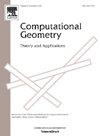Parallel line centers with guaranteed separation
IF 0.4
4区 计算机科学
Q4 MATHEMATICS
Computational Geometry-Theory and Applications
Pub Date : 2025-03-18
DOI:10.1016/j.comgeo.2025.102185
引用次数: 0
Abstract
Given a set P of n points in the plane and an integer , the k-line-center problem asks k slabs whose union covers P that minimizes the maximum width of the k slabs. In this paper, we introduce a new variant of the k-line-center problem for , in which the resulting k lines are parallel and a prescribed separation between two line centers is guaranteed. More precisely, we define a measure of separation, namely the gap-ratio of k parallel slabs, to be the minimum distance between any two slabs, divided by the width of the smallest slab enclosing the k slabs. We present efficient algorithms for the following problems: (1) Given a real , compute k parallel slabs of minimum width that cover P with gap-ratio at least ρ. (2) Compute k parallel slabs that cover P with maximum possible gap-ratio. Our algorithms run in and time, respectively, using space, where denotes the maximum possible gap-ratio of any k parallel slabs that cover P. Using linear space, the running times only slightly increase to and .
平行线中心,保证分离
给定平面上有n个点的集合P,且整数k≥1,k线中心问题要求k个板,其并集覆盖P,使k个板的最大宽度最小。本文引入了k≥2时k-线中心问题的一个新变体,其中k条线是平行的,并且保证两条线中心之间有规定的间隔。更准确地说,我们定义了一种分离度量,即k块平行板的间隙比,是任意两块板之间的最小距离,除以围住k块板的最小板的宽度。我们给出了以下问题的有效算法:(1)给定一个实数0<;ρ≤1,计算k个覆盖P的最小宽度平行板,其间隙比至少为ρ。(2)以最大可能的间隙比计算覆盖P的k个平行板。我们的算法运行时间分别为O(ρ−k⋅(nlog (n) +kn))和O(ρmax - k⋅(nlog (n) +kn)),使用O(knlog (k))空间,其中ρmax表示覆盖p的任意k个平行平板的最大可能间隙比,使用线性空间,运行时间仅略微增加到O(ρ−k⋅klog (n))和O(ρmax - k⋅klog (n))。
本文章由计算机程序翻译,如有差异,请以英文原文为准。
求助全文
约1分钟内获得全文
求助全文
来源期刊
CiteScore
1.60
自引率
16.70%
发文量
43
审稿时长
>12 weeks
期刊介绍:
Computational Geometry is a forum for research in theoretical and applied aspects of computational geometry. The journal publishes fundamental research in all areas of the subject, as well as disseminating information on the applications, techniques, and use of computational geometry. Computational Geometry publishes articles on the design and analysis of geometric algorithms. All aspects of computational geometry are covered, including the numerical, graph theoretical and combinatorial aspects. Also welcomed are computational geometry solutions to fundamental problems arising in computer graphics, pattern recognition, robotics, image processing, CAD-CAM, VLSI design and geographical information systems.
Computational Geometry features a special section containing open problems and concise reports on implementations of computational geometry tools.

 求助内容:
求助内容: 应助结果提醒方式:
应助结果提醒方式:


